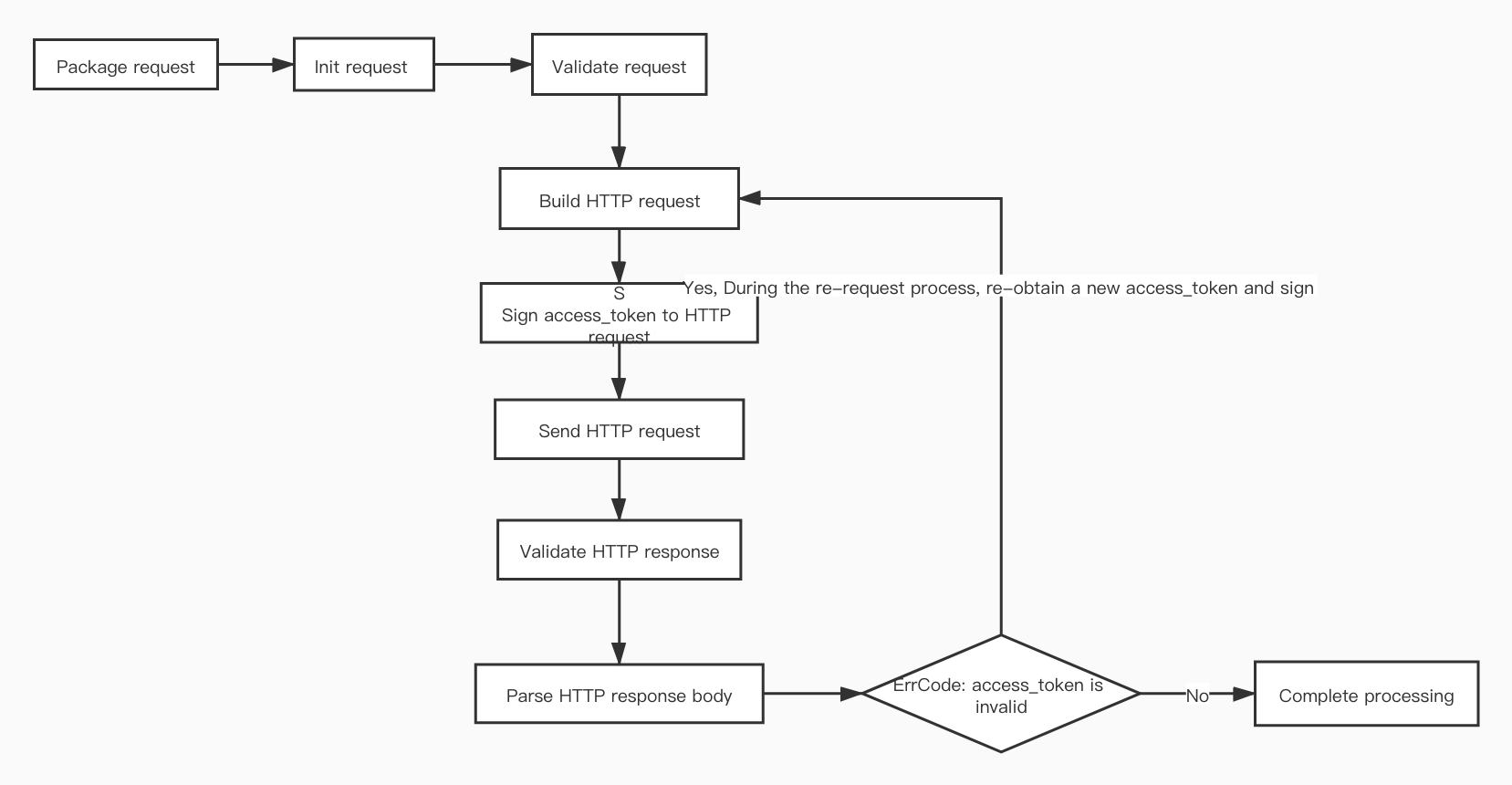| Module | description |
|---|---|
| core | Application information configuration and some general methods |
| api | Request the interface of larksuite/feishu |
| event | Monitor the business data of larksuite/feishu changes and events generated |
| card | Monitor the actions of message card interaction |
| service | Generated business SDK(api&event) |
| sample | Example |
$ go get -u github.com/larksuite/oapi-sdk-go- Instructions for use
- Get application configuration
- Provide code sample GetConfig()
- Use redis achieve Store Interface, for maintenance
app_ticket、app_access_token、tenant_access_tokenlife cycle - Use logrus to implement Logger Interface
- Use redis achieve Store Interface, for maintenance
- Instructions for the method are as follows:
// Create application configuration to prevent leakage. It is recommended to put application information in environment variables. // Environment variable or parameter name: // APP_ID: App ID in the application certificate // APP_SECRET: App Secret in the application certificate // VERIFICATION_TOKEN: Verification Token in the event subscription // ENCRYPT_KEY: Encrypt Key in the event subscription, yes Empty, indicating that the event content is not encrypted // The configuration of the enterprise self-built application appSettings := config.NewInternalAppSettings("[APP_ID]", "[APP_SECRET]", "[VERIFICATION_TOKEN]", "[ENCRYPT_KEY]") // Enterprise The configuration of self-built applications, the application configuration is obtained through environment variables appSettings := config.GetInternalAppSettingsByEnv() // App Store application configuration appSettings := config.NewISVAppSettings("[APP_ID]", "[APP_SECRET]", "[VERIFICATION_TOKEN]", "[ENCRYPT_KEY]") // App store application configuration, obtain application configuration through environment variables appSettings := config.GetISVAppSettingsByEnv() // Create Config // domain: domain name http address: constants.DomainFeiShu/constants.DomainLarkSuite // appSettings: application configuration // logger: [log interface](core/log/log.go) // loggerLevel: output log level log.LevelDebug/LevelInfo/LevelWarn/LevelError // store: [Storage interface](core/store/store.go), used to store app_ticket/app_access_token/tenant_access_token // used in online config conf := config.NewConfig(domain, appSettings, logger, loggerLevel, store) // Config for development and testing // logger: use the default implementation(core/log/log.go defaultLogger) // loggerLevel: Debug level // store: use the default implementation(core/store/store.go DefaultStore) conf := config.NewTestConfig(domain, appSettings) // Create CoreContext(*core.Context) for API requests, Event callbacks, Card callbacks, etc., as function parameters // core.Context implements the context.Context interface coreCtx := core.WrapContext(context.Background()) // Get the RequestID(string) of API requests, Event callbacks, and Card callbacks, used for problem feedback, open platform query related logs, you can quickly locate the problem requestID := coreCtx.GetRequestID() // Get response to API request Status code(int) statusCode := coreCtx.GetHTTPStatusCode()
- Provide code sample GetConfig()
- Get application configuration
-
Processing flow
-
Business API SDK that has been generated
Business service version path sample Authentication v1 service/authen sample/api/authen.go Image v4 service/image sample/api/image.go Contact v3 service/contact sample/api/contact.go Calendar v4 service/calendar sample/api/calendar.go Drive v1 service/drive sample/api/drive.go -
Instructions for use(For
No business API SDK is generatedthe processing method)- For
App Store application, when acquiringapp_access_token, you needapp_ticketto start the event subscription service(Module event) - Usage example
- The package request is as follows:
import( "github.com/larksuite/oapi-sdk-go/core/config" "github.com/larksuite/oapi-sdk-go/core/constants" "github.com/larksuite/oapi-sdk-go/core/log" "github.com/larksuite/oapi-sdk-go/api/core/request" "github.com/larksuite/oapi-sdk-go/api/core/response" ) // Create request // httpPath:(path after `open-apis/`) API path, for example: https://{domain}/open-apis/authen/v1/user_info, the httpPath: "authen/v1/user_info" // httpMethod: GET/POST/PUT/BATCH/DELETE // accessTokenType: which token access is used by the API, value range: request.AccessTokenTypeApp/request.AccessTokenTypeTenant/request.AccessTokenTypeUser, for example: request.AccessTokenTypeTenant // input : Request body(may be request.NewFormData()(for example: file upload)), if the request body is not needed(for example, some GET requests), then pass: nil // output: response body(output := response["data" ]) // optFns: extended function, some uncommon parameter packages, as follows: // request.SetPathParams(map[string]interface{}{"user_id": 4}): set the URL Path parameter(with: prefix) value, When httpPath="users/:user_id", the requested URL="https://{domain}/open-apis/users/4" // request.SetQueryParams(map[string]interface{}{"age":4,"types":[1,2]}): Set the URL qeury, will append to the url?age=4&types=1&types=2 // request.setResponseStream(), set whether the response is a stream, such as downloading a file, at this time: output value is Buffer type // request.SetNotDataField(), set whether the response does not have a `data` field, business interfaces all have `data `Field, so you don’t need to set // request.SetTenantKey("TenantKey"), as an `app store application`, it means using `tenant_access_token` to access the API, you need to set // request.SetUserAccessToken("UserAccessToken"), which means using` user_access_token` To access the API, you need to set // req := request.NewRequestWithNative(httpPath:string, httpMethod:string, accessTokenType:AccessTokenType, input:interface, output:interface, ... optFns:OptFn [))) // Example: body := map[string]interface{}{ "open_id": "[open_id]", "msg_type": "text", "content": map[string]interface{}{ "text": "test", }, } ret := make(map[string]interface{}) req := request.NewRequestWithNative("message/v4/send", "POST", request.AccessTokenTypeTenant, body, &ret) coreCtx := core.WarpContext(context.Background()) err := api.Send(coreCtx, conf, req) fmt.Println(coreCtx.GetRequestID()) fmt.Println(coreCtx.GetHTTPStatusCode()) if err != nil { fmt.Println(tools.Prettify(err)) e := err.(*response.Error) fmt.Println(e.Code) fmt.Println(e.Msg) return } fmt.Println(tools.Prettify(ret))
- Tool
Tool path description file download api/core/tools/file.go For example, you can download pictures for picture upload - For
- Processing flow
-
Encapsulated
App Store applicationTheapp_ticketevent (you need to set the event handler again), store it in the Store forModule apiuse- Decryption of event data and verification of source reliability
-
Business Event SDK that has been generated
Business service version path sample application v1 service/application sample/event/application.go contact v3 service/contact sample/event/contact.go -
Instructions for use
- Event monitoring service started
- For
No business Event SDK is generatedthe treatment - Set the event handler, for example:
import "github.com/larksuite/oapi-sdk-go/event" // conf: config.Config // app_status_change: event type // func // coreCtx: *core.Context // event: map[string]interface{} // return: // error: not nil, response status code 500 event.SetTypeCallback(conf, "app_status_change", func(coreCtx *core.Context, event map[string]interface{}) error { fmt.Println(coreCtx.GetRequestID()) fmt.Println(tools.Prettify(event)) data := event["event"].(map[string]interface{}) fmt.Println(tools.Prettify(data)) return nil })
-
- Encapsulated
- Verification of the validity and source reliability of card data
- Instructions for use
- Message card callback service started
- Set the message card handler, the code is as follows:
import "github.com/larksuite/oapi-sdk-go/card" // conf: config.Config // func // coreCtx: *core.Context // card: *model.Card // return: // interface{}: can be string(json string of message card) or map(The map package of the message card) // error: not nil, response status code 500 card.SetHandler(conf, func(coreCtx *core.Context, card *model.Card)(interface{}, error) { fmt.Println(coreCtx.GetRequestID()) fmt.Println(tools.Prettify(card.Action)) return nil, nil })
